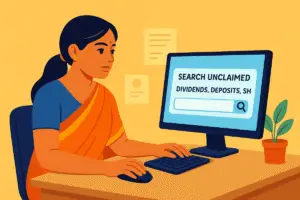Introduction — Why this campaign matters to you
Imagine discovering that money you or a family member saved years ago—an old bank fixed deposit, a matured insurance policy, an unpaid dividend, or a mutual fund redemption—has been waiting to be claimed. The Government of India’s nationwide special awareness drive, “Your Money, Your Right”, launching on 4 October 2025 and running through December 2025, is aimed at helping every citizen find and reclaim such unclaimed financial assets.

This campaign is not just a publicity exercise. It brings together the Reserve Bank of India (RBI), Insurance companies (including LIC), Securities & Exchange Board of India (SEBI), Investor Education & Protection Fund (IEPF) and financial institutions to provide one clear message: every rupee that belongs to you should be traceable and claimable. The drive will combine digital portals, local help desks, SOPs (Standard Operating Procedures), FAQs and on-ground support to make the process simple and transparent.
Quick links to start checking right away:
What assets are covered under “Your Money, Your Right”
The campaign covers a wide range of financial assets that commonly go unclaimed:
- Bank deposits: inactive or dormant savings, current, and fixed deposits transferred or listed as unclaimed.
- Insurance proceeds: maturity amounts, survival benefits or death claims that have not been collected by policyholders or nominees.
- Dividends & shares: unpaid dividends and share entitlements that may have been transferred to IEPF due to prolonged inactivity. The IEPFA safeguards unclaimed dividends, deposits, and shares, ensuring investors get their rightful money while spreading financial awareness across India.
- Mutual fund proceeds: redemption payouts or dividend amounts not collected due to outdated contact/KYC details.
How the campaign will help you (What to expect)
During the three-month drive, expect a combination of digital and on-ground measures:
- Help desks and booths in banks, insurance branches and public venues to demonstrate search & claim steps.
- Digital clinics showing how to use official portals and update KYC/nominee details.
- Distribution of SOPs and FAQs prepared by RBI, IRDAI/insurers, SEBI/IEPF and financial intermediaries so claimants know exactly which documents are needed.
- Escalation channels and timelines to resolve complex succession or legal-heir claims.
Step-by-step: How to check and claim your money
1. Bank deposits — Use RBI’s UDGAM Portal
UDGAM (Unclaimed Deposits — Gateway to Access Information) is RBI’s central search portal for dormant/unclaimed bank deposits across participating banks. Steps:
- Visit: UDGAM Portal.
- Register with your name and mobile number, then search by name and bank(s). Use PAN/Account No/DOB/Voter ID/Passport as identifiers.
- If a match appears you will get a UDRN (Unique Deposit Reference Number) and the bank branch details.
- UDGAM only locates funds — to claim, approach the listed bank branch with KYC and supporting documents to complete the bank’s claim process.
2. Insurance policies — LIC & other insurers
LIC and many insurers provide an online check for unclaimed policy amounts. Follow these exact LIC steps:
- Go to the LIC Unclaimed Amounts Portal.
- Enter Policy Number, Name* and Date of Birth*. Any two (Fields marked * are compulsory.)
- Click Submit — results appear instantly. If an unclaimed amount exists, follow LIC’s claim instructions and present KYC/nominee/legal-heir documents at the LIC branch or as directed online.
3. Dividends, shares & mutual funds — IEPF & SEBI routes
Unclaimed corporate dividends and shares may be held by the IEPF (Investor Education & Protection Fund). Mutual fund houses (AMCs) maintain records of unclaimed payouts. Steps:
- Check the company’s investor relations / registrar portal or the AMC’s website for unclaimed entitlements.
- If assets are with IEPF, visit the IEPF Refund Portal, it will take you to site of MCA and file the prescribed forms (e.g., Form IEPF-5) with KYC and entitlement proof.
- Follow the verification process and collect the refund once the authority/registrar confirms the claim.
Common questions (Quick FAQ)
- Q — Can I get the money directly from RBI or UDGAM?
- A — No. UDGAM is a locator service. You must claim funds from the bank shown in the UDGAM result.
- Q — What documents are typically required?
- A — Identity (Aadhaar/PAN/passport), proof of address, original policy/share documents (if available), nominee or legal heir proof (if relevant). SOPs from regulators list exact requirements.
- Q — My relative is deceased. Can I still claim?
- A — Yes. Nominees or legal heirs can claim. Depending on the asset and value, you may need succession certificate, legal heir certificate, or probate. Follow the SOPs provided by the bank/insurer/company.
- Q — How long will the process take?
- A — Time varies by institution and the complexity of the claim. SOPs give estimated timelines; help desks during the campaign will guide expected durations.
Final words — Don’t let your money remain hidden
The “Your Money, Your Right” campaign (4 Oct 2025 — Dec 2025) is your invitation to check, claim and recover funds that belong to you or your family. Use the official portals listed above, visit local help desks during the campaign, update KYC and nominee details, and help spread awareness in your community. Your savings are your right — reclaim them.
Also read for more Details Funds lying with LIC of India
Also read for more Details regarding unclaimed Bank Deposits
Disclaimer: This article is for awareness only. For accurate procedures and the most recent updates, always refer to the official portals: UDGAM (RBI), LIC unclaimed amounts page, IEPF/SEBI and official guidelines. This blog does not accept liability for errors or omissions.
